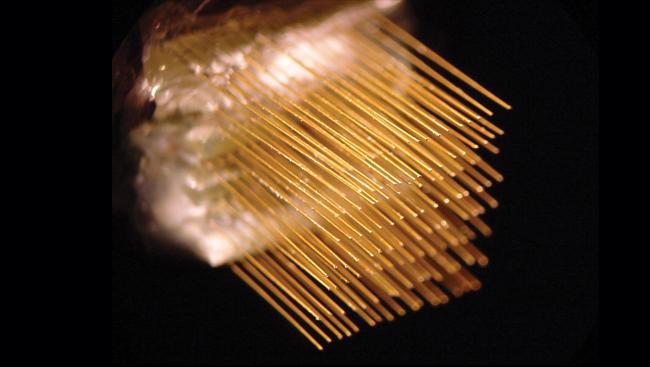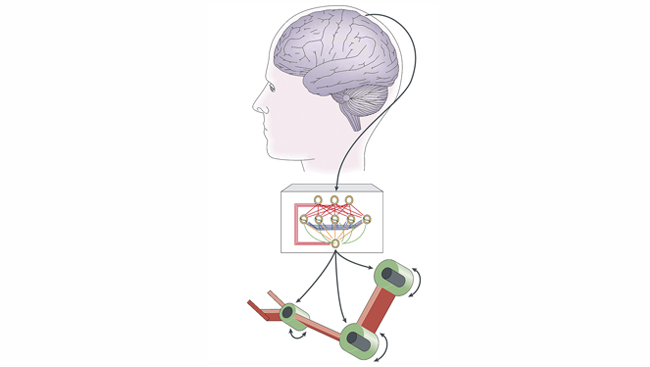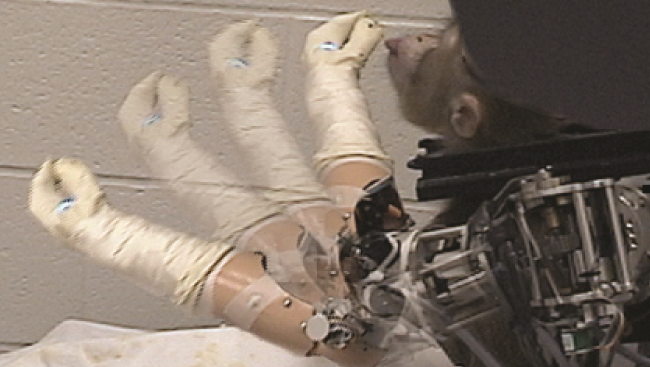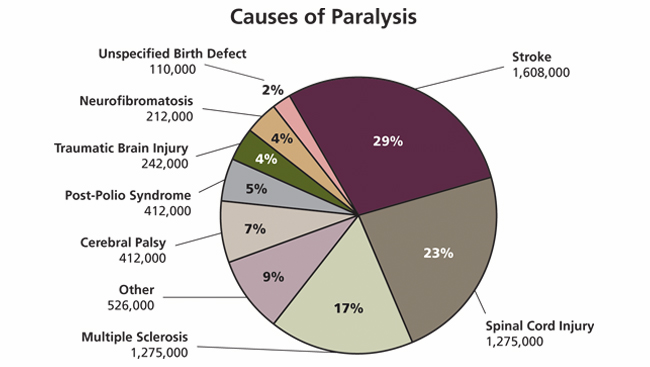Brain Machine Interface
- Published1 Nov 2010
- Reviewed1 Nov 2010
- Author Sarah Bates, MS, MA
- Source BrainFacts/SfN
Formerly only in the domain of fantasy, brain-controlled devices now exist. These complex robotic tools are made possible by past studies of nerve cell communication.This has implications for the approximately 5.6 million Americans, about 1.9 percent of the population, who are paralyzed. While some treatments focus on ways to repair the damage, other approaches aim to restore some independence by helping patients control a device, such as a robotic arm or computer cursor.
Finding out how the brain controls movement
Every handshake or footstep is the result of the brain exchanging information with an arm or leg. But what if that link is severed? Research shows function may be restored with mechanical limbs. Such brain-machine connections are now possible because of experiments that examined nerve cell communication.
Strength in Numbers of Neurons
In the 1920s, researchers investigating electrical activity in the brain noticed the signals they recorded varied with a person's behavior. Nerve cells in the brain called neurons communicate with each other via chemicals and bursts or "spikes" of electricity. Using instruments attached to the outside of the scalp, the researchers found evidence that these signals are related to behavior.
Years later, scientists recorded signals from individual nerve cells by implanting tiny rigid wires in the brains of macaque monkeys. They found each cell in the motor cortex, the brain's movement control center, responded differently when the monkey moved its arm in certain directions. This led researchers to believe single neurons controlled behavior.
However, subsequent research showed the collective effort of nerve cells working together directs behavior. In the early 1990s, arrays of implanted electrodes with flexible wires allowed researchers to record almost 50 neurons at once in a conscious animal. As the animal moved, each cell's electrical signal changed and was logged. These studies suggested brain cells compute in clusters, not in isolation. This was a surprising finding.
Although basic tools had been developed to tap into the brain's electrical signals, the full potential of that discovery was still unknown. Researchers needed a way to apply those extracted signals to restore motor function; they needed an interface between neurons and artificial devices.
Animals control machines with their brains
Researchers worked to create a system that could continuously tap into diverse populations of neurons, convert their signals into commands a robot could understand, and then immediately transmit those commands to the machine. Basic science research in animals helped identify three essential components to a brain-machine interface: simply thinking of an action activates motor-control neurons; the signals from hundreds but not thousands of motor neurons are needed to imitate natural movement; and sensory feedback is necessary for proper control of a brain-directed prosthetic.
Movement Without Flexing a Muscle
Remarkably, researchers found that thinking about a motion activates neurons in the same pattern that actually making the movement does. In one early experiment, a rat was trained to expect a reward when it pressed a lever. Researchers then disconnected the lever from the reward and equipped the rat with an electrode array that collected and processed data from about 50 neurons in the motor cortex involved in lever pressing. Even then, the rat still attained the reward, despite never physically touching the lever.
Scientists then attempted to design a robotic arm that mimicked the motions of a monkey's arm. The researchers found that to accurately reproduce motion, they had to record many, but not all neurons involved in arm movement. They sampled 50 to 100 neurons throughout the arm sensation and movement control areas in a monkey's brain at any given time. Signals from those neurons were processed and rerouted to control a robotic arm. When the monkey reached for a piece of fruit, so did the machine. This finding suggests that people who are injured or ill can still make use of brain-directed prosthetics even with nerve cell loss.
Also during these landmark experiments, researchers found when they displayed a visual indicator of a neuron's activity, a monkey could learn to move its limbs to control the cell firing rate. This discovery suggested that, with training and proper sensory feedback, people could learn to control brain signals to operate complex robotic devices. In this way, machines could act in lieu, not in imitation, of a hand or an arm.
New solutions for paralyzed people
Thanks to the success of animal studies, pieces are in place to apply brain-machine systems to the most complex organ: the human brain. Human tests of brain-controlled prosthetics have already begun. In carefully monitored clinical trials, paralyzed people have had sensors surgically implanted in their brains to allow them to move a glass of water or use a computer.
Building a Better Machine
Privately held companies are teaming up with government agencies and academic institutions to develop viable brain-operated robotic devices and computers. In one early trial, a participant controlled a cursor on a computer screen, an activity he had been unable to do since an accident severely damaged his spinal cord. One paralyzed volunteer with an implant recently demonstrated her ability to move a robotic arm with her thoughts. The woman directed the arm to pick up a glass and set it back down.
Similar systems also have given new voices to people unable to speak. The most well-known user of communication technology is the physicist Stephen Hawking, who has a slowly progressing form of amyotrophic lateral sclerosis. Although Hawking uses two fingers to construct sentences on a speech-capable computer, researchers aim to develop such communication systems to act on thought only.
So far individuals have largely received implants that physically plug into machines. Although implants are most effective at reading brain signals, non-invasive interfaces for humans are in development to avoid risk of infection and tissue damage. Even small advances are huge improvements for people who are "locked in" to their bodies due to paralysis.
New Scale of Science
Brain-machine research has given scientists new insight into how the brain works. Before such research, scientists were uncertain how strokes or injuries alter the brain's ability to control the body. Now, thanks to brain-machine connections that track neuron activity in exquisite detail, scientists know that if a lost connection is restored, the brain may still be able to relay motor commands. This finding has profound implications for both machine-assisted recovery and spinal cord repair.
CONTENT PROVIDED BY
BrainFacts/SfN
Also In Archives
Trending
Popular articles on BrainFacts.org






















